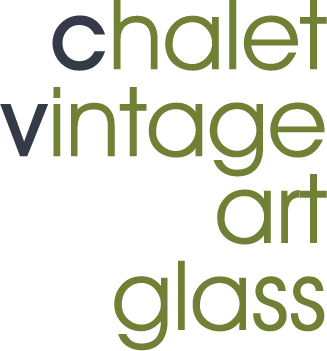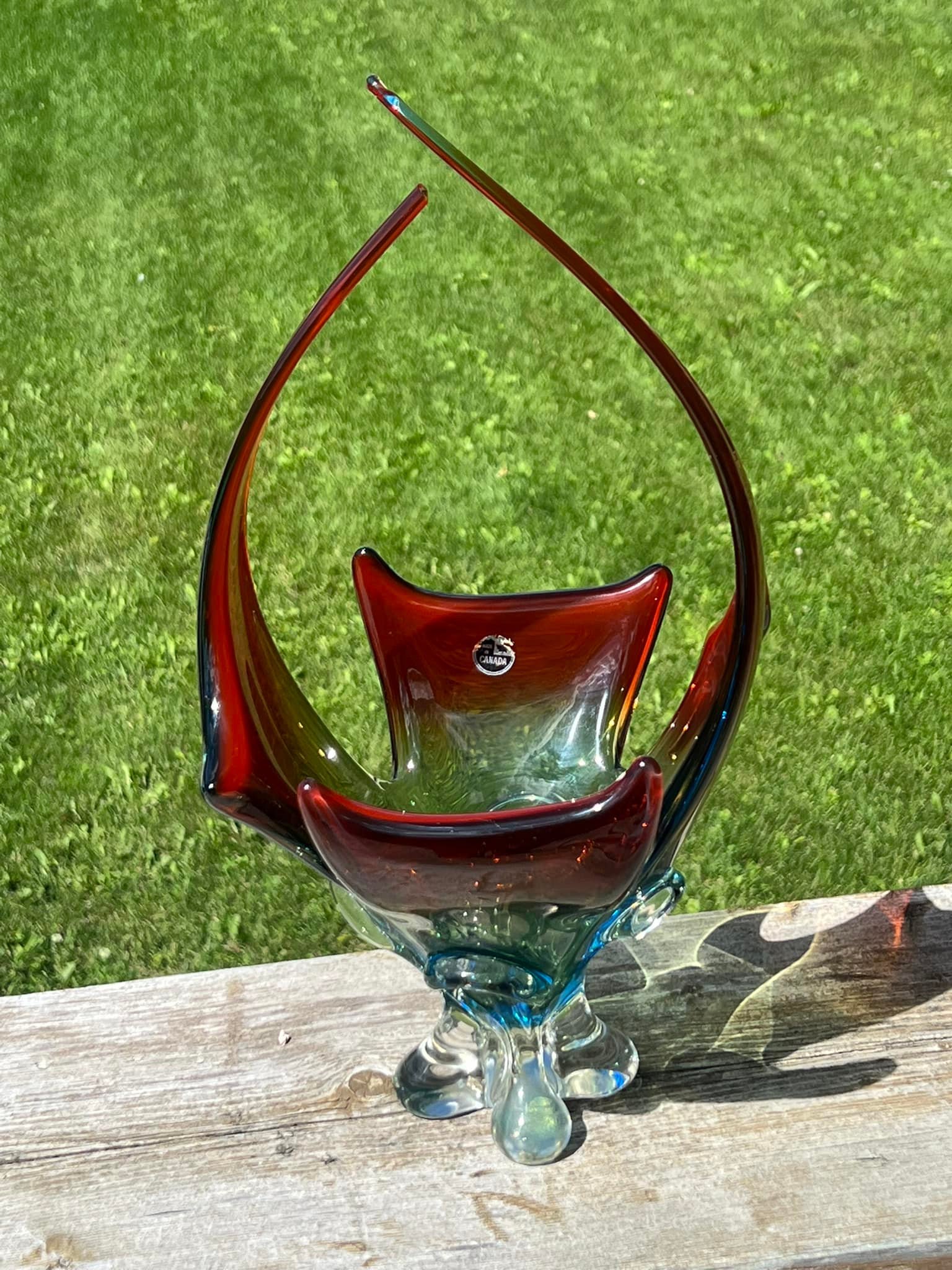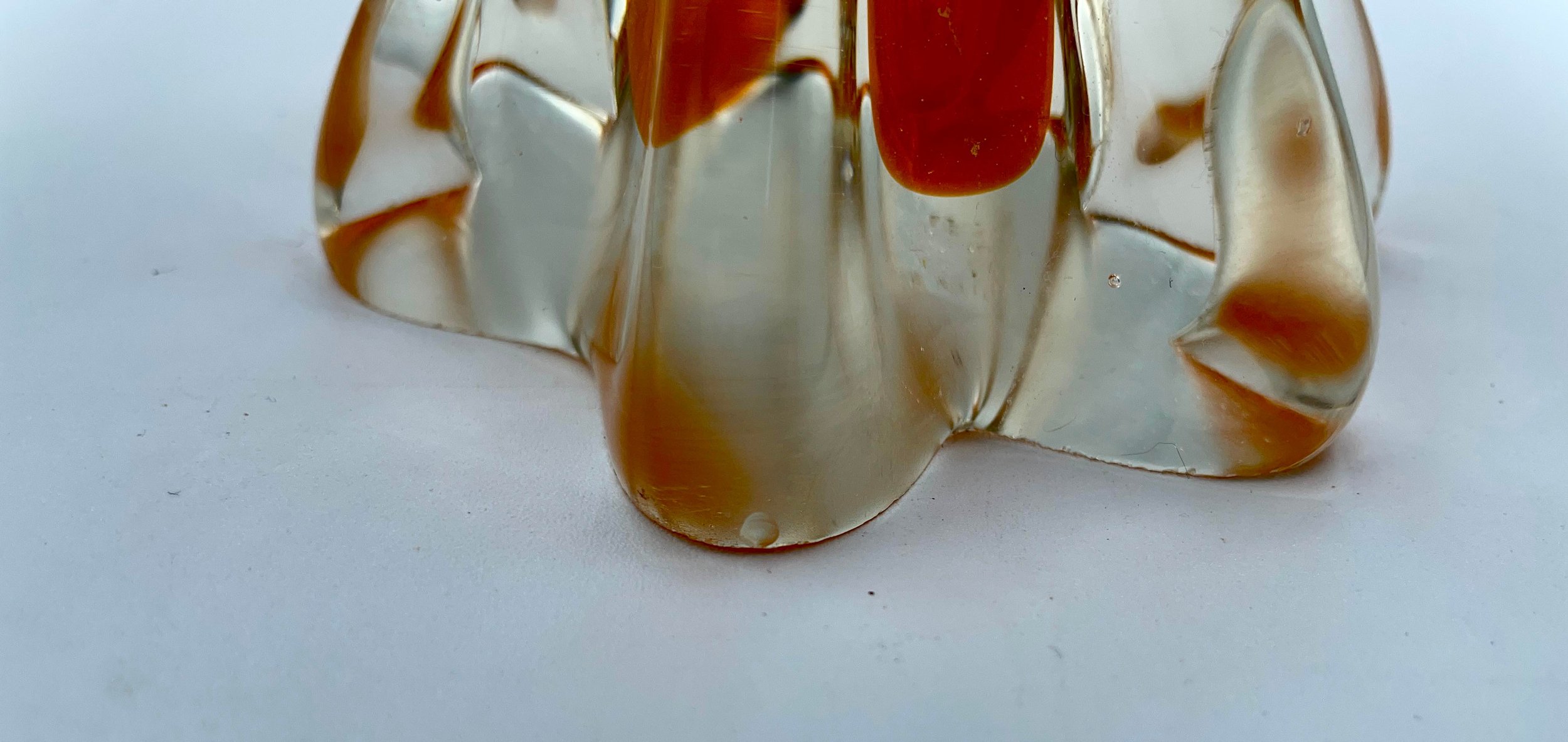Art Glass Damage and Flaws
Not all art glass is created equal. And even when it is – time and tragedy can take its toll. I administer 2 Facebook groups for Canadian art glass collectors. The top 3 repeated questions within both are: “Who made this?” “Should I buy a piece that isn’t perfect?” and “Does damage or a flaw affect the price or value of a piece?” So, what is damage and what is a flaw? And how is the value of a piece affected? Not only in aesthetics but in selling/buying prices.
Damage pertains to defects after the manufacturing process caused through age, use, handling, cleaning, shipping or storage. Damage includes broken off pulls or “arms”, nicks/flakes, chipping, cracks, scratches, over heating, age related wear like rubbing, “ kisses” and water staining. Repairs also fall under damage as broken or damaged glass even if it has had a repair is still broken or damaged glass. Damage generally dramatically lowers the value of any piece. Flaws pertain to defects occurring during the manufacturing process. Flaws include visible marks or inclusions. Flaws do not always negatively affect value but they may - depending on visibility, severity, and the rarity of the piece itself. Flaws and the resulting impact, if any, on the desirability and value of the piece are viewed much more subjectively to both a seller and buyer.
Commonly seen Damage:
bottom wear: very commonly seen damage on the underside of the base of the glass form. It is created over time by normal, everyday usage. Most typically seen damage in this area is one or more of: rubbing, scratches, scuffs, shallow chips, flakes, and flea bites. See following for detailed information and examples regarding specific to these types of damage. Bottom wear often helps indicate the age of an item - it is certainly very typical of vintage glass. Most age-related bottom wear usually does not detract from the value of a piece.
You can see the rubbing, scratches and a small chip on the base underside of this Chalet piece. This is an excellent example of time and use resulting in age related wear. Value of this piece would not be affected by this age typical wear.
The crystal swirl bases found on the the Chalet “splash” vases and ashtrays, the “tornados”, some of the “ribbons” having this base design and the large crystal swirl vases seem especially prone to flea bite and chip damage.
broken off arms, pulls etc.: an obvious result of time and use for vintage glass. Most commonly seen in the upward tapering arms of basket centerpieces or the outward elongated arms of stretch centerpieces. However, it is not unusual to also see this on the pulls of ashtrays, cigar bowls or on more elaborate design elements of other pieces. Most collectors view this type of damage as rendering the piece a “give-away’ or use it in their gardens or if it is special piece, use as a place holder until and if they are lucky enough to find it intact.
Unfortunately damage occurs to the rare and scarce as well as to the ordinary. This Lorraine tie-dye basket is a casualty of time while both the purple “Canada Art” engraved Chalet cigar bowl (above) and the purple “Chalet Canada” etched stretch (to the right) were victims of poor shipping. The basket and stretch have a “loving home” with 50 Shades member Roger Lambert.
chips: shallow chips are generally smaller chips, but which are still larger than than 1/4”. Less immediately visible upon viewing the item. deep chips are chips which are deep and wide enough to be visible immediately. Chips do adversely affect the value of a piece unless they are limited to the base underside.
The chip on the pedestal foot of this piece is quite shallow and is fairly inconspicuous. Impact on value of a chip this size and where it is found could be subjective and if the piece is rare or scarce, the negative impact will be even less.
A chip this deep, large and visible (even if on the side of the base) renders this piece virtually worthless.
Cracks: a break within the structure of the form. Usually immediately visible upon inspection of the piece. A hairline crack is a very tight, narrow crack which does not affect the structural integrity of the piece and is usually not immediately visible. An internal fracture crack runs deep and long within the structure of the piece and in most cases weakens the structure of the form. These types of cracks are usually much more visible. It may or may not spread over time and can be affected by temperature changes and stress. Can ultimately reach surface. Cracks do adversely affect value of piece. The vase in the video immediately below is an example of a piece with a hairline crack. In fact, it actually has 2.
Note the small hairline cracks present on the ends of this EDAG “twisted tips” vase.
Now this is a crack worthy of the label ‘fracture!” For 3 years 50 Shades member Alex Wicks has been wondering what is keeping the piece together - he’s watching it with fascination.
filed etc. “repairs”: after manufacture repairs done typically on broken arms of basket and stretch centerpieces. Can have been done either at the factory or by a previous owner. Factory repairs can be so expertly done that the piece appears undamaged unless very thoroughly inspected. Owner repairs, either by filing or heating the damage to blunt it, are usually very obvious. Repaired pieces, regardless of rarity, are considered virtually worthless by the vast majority of collectors.
Both horizontal “arms” on this massive Murano stretch were damaged. The pictures immediately following show the filed tips - the blunting was very well done. However, again, both the damage and repairs, no matter how well done, render this piece virtually worthless.
Lorraine Glass Industries made both these baskets. However, only one is intact. The basket on the right has obvious “home repairs.” Both broken arms have been filed and also note the blackened left “arm” tip.
The Morrisburg flea market (very near Cornwall) seller from whom I bought this Chalet “6 arm” pointed out the repair when I expressed interest in purchasing. It was so expertly done that I would not have noticed it otherwise. He had purchased the piece from its original and only owner who had bought it at a “Seconds” sale right at the Chalet factory. Chalet had a annual Christmas sale in which discontinued lines and forms and less-than-perfect pieces were prominently featured. Can you spot the repaired damage? I paid very little for this piece and was over joyed to get it, even with a repair, as Chalet “6 arms” are very scarce.
impact wounds/”kisses”: very shallow indents less than 1/4” not breaking the surface of the glass. Usually made from the glass repeatedly bumping up against another object. Most often happens when 2 objects are shipped together and the protective packing is not adequate. Do adversely affect value of piece unless on base. This is a rarer type of damage as usually repeated impact results in the surface of the glass being broken. The kisses on this duck figurine in 50 Shades member Jeremiah Shaver’s collection are impossible to feel with a fingertip. Notice the “impact wounds” closeup in the photograph below the video. They are very unique. This figurine was made by Maestro Angelo Rossi for Jeremiah’s father.
nicks/flakes: small, shallow chips less than 1/4” breaking the surface of the glass. Do adversely affect value of piece unless on base.
These nicks/flakes definitely would have a negative impact on the value of this piece as they are located on the tip of one of the “arms” of this Chalet “gondola” centerpiece. This form is all about its shape so for damage to be present on a defining design feature is to the definite detriment of the piece.
Here is an example of a gondola centerpiece with undamaged tips. You can see what a difference this makes.
These nicks and flakes are obtrusive and visible on the body of this piece - no matter who tells you, “They are hardly noticeable.”.
fleabite: may also be referred to as a “pinpoint nick” or "chigger-bite." One of the most common forms of damage. A tiny, fairly little nick or chip generally 1/16" or smaller in size (roughly the size of a pencil or pin head). Fleabites are most often found on both the flat and side of the base of vintage glass pieces and flea bites on the underside of the base do not detract from its beauty or value. They should not dissuade a collector from purchasing a piece but do adversely affect the value of a piece when they are on the body of the form.
scratches: vary in depth and length. However, please note that there are actually some external marks that occurred during the manufacturing process and are flaws not not damage although they are often mistaken for such. See “straw marks” in the “Flaws” section below for specifics. A true scratch, no matter how shallow or minor, always feels raised, rough or sharp to the fingertip as the surface of the glass has been compromised. Scratches do adversely affect value of a piece.
A very light scratch which since it is on the body will negatively impact value of a piece unless it is rare or scarce. In the case of this little EDAG bird, the negative impact will be slight or maybe not at all as EDAG animal figurines are quite scarce and the scratch here is so minor.
This Murano bullicante ashtray base is an excellent example of 2 things - deeper scratch marks which would be felt by a fingernail and typical bottom wear. This “age expected/appropriate wear” will not affect the value of this piece.
scuff/rub: small areas of concentrated scratches or wear, generally caused by repeated touching of items over time. Does adversely affect value of piece unless on underside of base.
smoked: glass that has been over-exposed to heat. It is literally “overcooked”. Depending on the degree of over-exposure, the glass may lose its transparency with the colour then looking “painted on” or it may lose all colour and turn completely opaque. Generally considered a novelty by buyers and may actually add value to the piece as they are eagerly collected.
Both these Chalet “crystal twists” have been over exposed to heat. Note the degree of transparency loss is markedly different in each vase.
This stretch was completely opaque. It had not been worked on at all given the over heating - its sides were so sharp that you could have easily cut yourself on them. I also bought it at the Morrisburg flea market near Cornwall. It had been taken home by a Chalet employee after it was discarded. Up to 25% of Chalet’s daily production (700-800 pieces) were ruled as being not top quality and either discarded or sold as a second. The owners and the glass blowing team’s Maestro would make the decision regarding inferior quality glass.
water marks/stains: patches, ridges, deposits and clouding on and of the glass caused by water left standing in the vessel for a lengthy period of time. The “wispy fog” water stain, often has a slight iridescent hue, the “cloudy fog” patches obscure the transparency of the glass and solid white marks often have a pronounced rough, raised white calcium deposit too which often collects dirt and dust as well which furthers the damage. All are impossible to remove and dramatically negate the value of any piece.
This “wispy fog” water stain (at left beside the clear crystal band) does show the irridescent hue. This Chalet “tornado” vase from the collection of 50 Shades member Ella Hanks. Ella was able to mask the stain so that it may be displayed in her collection by applying WD40 to just that area.
An example of a larger, deeper water stain. Transparency of the glass is affected but loss limited. Is moving into “cloudy fog” intensity. See photo to the right.
An intense “cloudy fog” water stain. Notice the degree of transparency lost by the glass. However, it does not have the raised white ridge that is created by calcium deposits also found on some pieces.
Common Flaws:
air bubbles: if bubbles are not deliberately introduced as part of the design, they can still occur when air pockets get trapped in the molten glass by happenstance. There is no one reason or definitive time when this is most likely to happen. A variety of factors come into play and many scenarios are possible - air bubbles could happen when gases in the mix interact and create oxygen, when the glass was sheared from the pontil, when the mix in the crucible was stirred, when the gather was collected on the canna… Hand made glass nearly always has a few small bubbles. However, good quality art glass will have only a very, very few.
maker's miss: art glass “slang” for a flaw (a pop, an air bubble, an unintentional inclusion) in the glass form caused or overlooked by the glass blower. Affect on value depends upon what type of flaw, the rarity of the piece and buyer perception. The impact on value, if any, in these cases is much more subjective.
open bubble/pop: a hole in the glass surface formed when a small air bubble broke the surface during manufacturing. The outer edge of the air bubble itself then burst. Usually has rough edges. Often has a divot-like shape. Does adversely affect value of piece.
The tip of this vase (foreground) has both a popped air bubble (at left close to top) and a hairline crack on the right (almost at e tip) running upwards and then spreading.
straw marks: very thin string-like and slightly bent lines left externally on the form. Often mistaken for hairline cracks but they are actually creases in the glass which occurred during manufacturing while the handmade glass cooled. It's important to know the difference as these do not adversely affect the value while cracks do. The best way to tell the difference is by touch. If you run your fingernail across the mark, it will feel smooth if it's a shear/straw mark. Kind of like a very small and narrow valley - not a rough or sharp ridge. They are often an indication of age. For example, it is most common to find these on pieces of Depression or Carnival Glass. However, shear/straw marks can also be found on vintage and even some more modern hand-blown forms. As stated above, they do not detract from value.
You can see how easily it would be to mistake this straw mark (on the bull’s shoulder) for a crack.
unintentional inclusion: the accidental presence of a foreign object(s) in the glass. An unintentional inclusion is a "maker's miss" and can be a trapped air bubble, a speck of charcoal from the furnace or un-melted raw material like sand. They can adversely affect the value of a piece but again, this can be more subjective.
Whenever I see an ash embedded in a piece of Chalet, I immediately flash to the photo to the right of Maestro Sergio Pagnin (left) learning over Maestro Giulio Gatto (working the piece). I love to think of this little whale figurine being a tangible “sign of those times” regarding much looser factory floor safety and protocols.
Makes me smile every time.
It is up to each collector to determine whether a damaged or flawed piece is worth the purchase. Sometimes circumstances warrant the buy. It may be a stand-in till you can find your “unicorn” in a more perfect condition. It may be that the piece is so rare that it’s a miracle that you can add it to your collection in any shape. It may be that its less than perfect condition will go unnoticed by how and where you display it.
One of the EDAG art glass pieces in this display is damaged - quite severely. Can you guess which one? Is it one of the bird centerpieces? The vase? Or the ashtray?








































